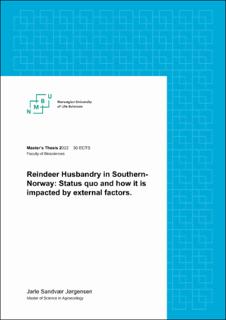| dc.contributor.advisor | Nicolaysen, Anna Marie | |
| dc.contributor.author | Jørgensen, Jarle Sandvær | |
| dc.coverage.spatial | Norway | en_US |
| dc.date.accessioned | 2022-09-20T12:42:29Z | |
| dc.date.available | 2022-09-20T12:42:29Z | |
| dc.date.issued | 2022 | |
| dc.identifier.uri | https://hdl.handle.net/11250/3019181 | |
| dc.description.abstract | Reindeer husbandry has been practiced in the artic regions for centuries and is one of few ways of utilizing natural resources in regions where plant productivity is marginal and weather conditions harsh. It is a trade which in Norway often is associated to the northern parts of Scandinavia and the indigenous Sami people, and few people are aware that Innlandet County holds the second largest semi-domestic reindeer population in Norway, and that they are owned and managed by four “non-indigenous” private reindeer companies. These four companies manage collectively nearly 20 000 reindeer during the summer season and produce 200 tons of reindeer meat each year.
The main discussions and focus in the literature and research on reindeer husbandry have been centred around the topic of conflicting interest between the reindeer husbandry practitioners, private landowners, and the state, who all have interests in the same regions. Another example of a topic in reindeer husbandry research is the phenomenon of global warming causing changes in weather patterns and the flora. Researchers point out a need for more knowledge in the field, and the importance of cross disciplinary studies in order to understand the collective environmental, social, and financial factors sustaining reindeer husbandry.
In this study I present the status quo of reindeer husbandry in southern Norway as well as identify how it is being impacted by external factors. It is based on the qualitative methods participant observation and interviews. I participated during Fram Reinlag’s yearly seasonal gathering and harvesting of reindeer and conducted interviews with stakeholders from all four reindeer companies from September to November 2021. The data was processed and analysed by applying principles from thematical analysis and content analysis. I organized the results through six overall themes: reindeer’s ecological impact and resource utilization; herding and practical management; grazing rights and landowner relations; finances and market; stewardship and tradition; & political will. | en_US |
| dc.language.iso | eng | en_US |
| dc.publisher | Norwegian University of Life Sciences, Ås | en_US |
| dc.rights | Attribution-NonCommercial-NoDerivatives 4.0 Internasjonal | * |
| dc.rights.uri | http://creativecommons.org/licenses/by-nc-nd/4.0/deed.no | * |
| dc.subject | Reindeer | en_US |
| dc.subject | Animal husbandry | en_US |
| dc.title | Reindeer husbandry in Southern Norway : status quo and how it is impacted by external factors | en_US |
| dc.type | Master thesis | en_US |
| dc.description.localcode | M-AE | en_US |

